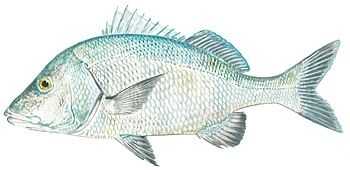White Margate

Species Details
Haemulon Album
Haemulidae
Perciformes
Inshore, Reef, Nearshore, Offshore
16 - 20 lbs.
10" - 30"
White Margate (Haemulon album) Description
The White Margate is the largest of the grunt fish family and can be distinguished from the Black Margate for its very high back profile. Its eyes are small with white irises. The coloring of its body can range from dull gray to silver. Dorsally, it has olive green coloring. Its fins are gray and its scales have dark spots on the upper area. It is also known for its rubbery lips.
Size and Diet
The White Margate matures at around 10 up to 20 inches in length, though they are also reported to reach at least 30 inches. The world record for this fish species is at almost 20 pounds.
The White Margate feeds on tiny bottom-dwelling water species such as bivalve mollusks, heart urchins, small fishes, crustaceans, and peanut worms. It is often obvious about its feeding as it will hunt for its food in a nose-down position over sand flats. It is also a nocturnal feeder.
Interesting Facts about White Margate
- The White Margate has a number of colorful nicknames such as Dogfish and Sweetlips.
- Grunts, the family to which the White Margate belongs, got their name for the sound they make when their flat teeth rub together. The sound itself is amplified by their air bladders.
- The White Margate is not a schooling fish, though it is sometimes found in pairs or in small groups.
- The White Margate is often mistaken for the Mutton Snapper. The difference between the two fish species is in the scale pattern.
- As the White Margate is a nocturnal feeder, by day, it can be found hanging out close to reefs and wrecks.
- The White Margate is oviparous, is known to be a multi-batch spawner, and has a partner for breeding.
- The White Margate is quite a delicacy. Foodies describe it as a cross between Red Snapper and Hogfish, with a light and moist taste. It works well sauteed, broiled, poached, or with ceviche and sous vide.
- The flesh of the White Margate, though, can have a strong odor. It can easily be rid of by freezing or soaking in salted water.
Fishing Technique: How to Catch White Margate
The White Margate is not that popular as a game fish. It is, in fact, mostly caught as a bycatch when anglers target big fishes. It is normally caught drift fishing or bottom fishing over clear water around coral reefs, rocky bottoms, wreck sites, and seagrass beds.
When deep water fishing over reefs, a heavy tackle with small circle hooks and small live baits or Bonito strips will work with the White Margate as well as other big game fishes you might want to target. Fishing for it in shallow waters, you can use a lighter tackle and pretty much the same type of bait, as the White Margate eats just about anything.
A big chunk of this fish species can be found in water 80 feet or less. It is often found in small groups or pairs over seagrass beds and flats of sand between reef patches. Bigger White Margate can be found in deeper depths up to 115 feet, along with other bigger game fish.
Like most grunts, the White Margate is not a big fighter but makes for good food.
Habitat and Distribution
The White Margate is native to the waters of the Western Atlantic Ocean, along the Florida Keys, Bermuda, Bahamas, and Brazil. It has also been found in the Gulf of Mexico.
This fish species, by day, can be found near coral reefs and wrecked structures, with depths between 60 feet to 200 feet. It can also be found drifting over seagrass beds and sand flats and is reported to enter shallower waters to look for food.
In the Bahamas, the White Margate can often be caught in shallower waters, but in Florida, they occur in deeper waters 50 to 150 feet in depth.







